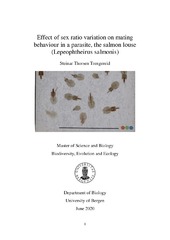| dc.description.abstract | In sexual organisms, females produce large gametes and their reproductive success is generally more limited by resources compared to males that produce many small gametes and are more limited by the number of mates. Because of this difference, females tend to be choosy when selecting a mate, and there is a lot of competition among males for females. To secure a mate, males may guard the female to prevent other males from mating with her. This ensures a higher chance of paternity, but also require time and energy that could otherwise be spent on finding additional mates. Because of this trade-off, one would expect that higher availability of unguarded females would decrease mate guarding duration. As the availability of unguarded females are based on the local sex ratio of males and females this means that one could expect shorter periods of mate guarding when the sex ratio is female biased (more females then males) and that the mate guarding duration is longer when the sex ratio is male biased (more males than females). Here we study sexual selection and mate guarding behaviour in a parasite that has a major economic impact, the salmon louse (Lepeophtheirus salmonis). Sexual selection in parasites are often ignored with studies more often focusing on how to exterminate them, how they have adapted to their host and on evolution of virulence. We hypothesized that more male biased sex ratio would lead to longer mate guarding duration in salmon louse while more female biased sex ratio would lead to shorter mate guarding. Another hypothesis was that smaller males would be less competitive and as such the males that fell off during the experiment would on average be smaller than those that remained until the end. The salmon louse is an ectoparasite which makes it easy to observe its behaviour on the host. We set up an experiment using 30 salmon and 100 salmon louse, 50 of each sex. We varied the initial sex ration in three experimental groups MMF, MMFF and MFF with M corresponding to male and F corresponding to female. The salmon louses were monitored every day with mate guarding behaviour being recorded as well as salmon louse that ended up in filters being taken pictures of for measurement. We found that the adult males that were lost from the host during the experiment tended to be smaller than those that remained until the end while for females there was no noticeable size difference. When the initial sex ratio was male biased, males guarded their mates for longer. We also found that the start of mate guarding was impacting the duration of mate guarding and that sex ratio seemed to not impact when guarding behaviour ended. This pattern of longer mate guarding when there is a male biased sex ratio has also been observed in some non-parasitic Crustaceans like Gammarus duebeni celticus, Alpheus angulatus and Caprella penatis. | en_US |
